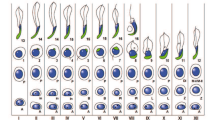Summary
The cellular distribution of H-Y antigen within the seminiferous tubules of testes from both 20-day-old and adult rats has been examined immunohistochemically. Large amounts of diffuse-staining material surrounding the germ cells were observed within the tubules of 20-day-old rats while the germ cells appeared to have little H-Y positive material on them. In the sexually mature rat, the seminiferous tubules contained cells at various stages of development. Peroxidase staining was evident on many, but not all of these cells. On spermatids and spermatozoa with cytoplasmic droplets attached, peroxidase staining appeared to be present in only a proportion of these cells.
Similar content being viewed by others
References
Bellve AR, O'Brian DA (1983) The mammalian spermatozoon: structure and temporal assembly. In: Hartmann JF (ed) Mechanism and control of animal fertilisation. Academic Press, New York London, pp 56–137
Bennett D, Boyse EA (1973) Sex ratio in mice of progeny inseminated with sperm treated with H-Y antiserum. Nature 246:308–309
Bradley MP, Heslop BF (1985) Elicitation of a rapid and transient antibody response to H-Y antigen by intrasplenic immunisation. Transplantation 39:643–648
Bradley MP, Heslop BF (1988) Recent developments in the serology and biochemistry of testicular sex-specific (H-Y) antigens. In: Wachtel SS (ed) Evolutionary mechanisms in sex determination. CRC Press, Boca Raton, Fla (in press)
Bradley MP, Forrester IT, Heslop BF (1987a) Identification of a male-specific (H-Y) antigen on the flagellar plasma membrane of ram epididymal spermatozoa. Hum Genet 75:362–367
Bradley MP, Ebensperger C, Wiberg UH (1987b) Determination of the serological sex-specific (Sxs) antigen (“H-Y” antigen) in birds and mammals using high-titer antisera and a sensitive urease ELISA. Hum Genet 76:352–356
Brunner M, Moreira-Filho CA, Wachtel G, Wachtel S (1984) On the secretion of H-Y antigen. Cell 37:615–619
Distel RJ, Kleene KC, Hecht NB (1984) The expression of haploidspecific genes including an α-tubulin during spermatogenesis in the mouse. Ann NY Acad Sci 438:523–525
Festing MFW (1979) Strain characteristics. In: Festing MFW (ed) Inbred strains in biomedical research. Macmillan, London, pp 267–296
Gerton GL, Millette CF (1986) Stage-specific synthesis and fucosylation of plasma membrane proteins by mouse pachytene spermatocytes and round spermatids in culture. Biol Reprod 35:1025–1035
Goldberg EH, Boyse EH, Bennett D, Scheid M, Carswell EE (1971) Serological demonstration of H-Y (male) antigen on mouse sperm. Nature 232:478–480
Hausman SJ, Palm J (1973) Serologic detection of a male-specific membrane antigen in the rat. Transplant Proc 5:307–310
Hecht NB, Bower PA, Waters SH, Yelick PC, Distel RJ (1986) Evidence for haploid expression of mouse testicular genes. Exp Cell Res 164:183–190
Hoppe PC, Koo GC (1984) Reacting mouse sperm with monoclonal H-Y antibodies does not influence sex ratio of eggs fertilised in vitro. J Reprod Immunol 6:1–9
Koo G, Stackpole C, Boyse E, Hammerling U, Lardis MP (1973) Topographical location of H-Y antigen on mouse spermatozoa by immunoelectronmicroscopy. Proc Natl Acad Sci USA 70:1502–1505
Koo G, Mittl LR, Goldberg GL (1979) Expression of H-Y antigen during spermatogenesis. Immunogenetics 9:293–296
Mollison PL (1979) Appendix. In: Mollison PL (ed) Blood transfusion in clinical medicine, 6th edn. Blackwell, Oxford, p 739
Müller U, Aschmoneit I, Zenzes MT, Wolf U (1978a) Binding studies of H-Y antigen in rat tissues. Hum Genet 43:151–157
Müller U, Siebers JW, Zenzes MT, Wolf U (1978b) The testis as a secretory organ for H-Y antigen. Hum Genet 45:209–213
O'Brian DA, Millette CF (1984) Identification and immunochemical characterisation of spermatogenic cell surface antigens that appear during early meiotic prophase. Dev Biol 101:307–317
Ohno S, Wachtel SS (1978) On the selective elimination of Y-bearing spermatozoa. Immunogenetics 7:13–16
Silver LM, Kleene KC, Distel RJ, Hecht RJ (1987) Synthesis of mouse t complex proteins during haploid stages of spermatogenesis. Dev Biol 119:605–608
Sylvester SR, Skinner MK, Griswold MD (1984) A sulfated glycoprotein synthesised by Sertoli cells and by epididymal cells is a component of the sperm membrane. Biol Reprod 31:1087–1101
Tung PS, Gore-Langton RE, Fritz IB (1982) An objective sperm cytotoxicity assay for male-specific antisera based on ATP levels of unlysed cells. Application to assay of H-Y antigen. J Reprod Immunol 4:315
Zaborski P (1979) Detection of H-Y antigen on mouse sperm by the use of Staphylococcus aureus. Transplantation 27:348–350
Zenzes MT, Müller U, Aschmoneit I, Wolf U (1978) Studies on H-Y antigen in different cell fractions of the testis during pubescence. Hum Genet 45:297–303
Author information
Authors and Affiliations
Rights and permissions
About this article
Cite this article
Bradley, M.P., Heslop, B.F. The distribution of sex-specific (H-Y) antigens within the seminiferous tubules of the testis: an immunohistochemical study. Hum Genet 79, 347–351 (1988). https://doi.org/10.1007/BF00282174
Received:
Revised:
Issue Date:
DOI: https://doi.org/10.1007/BF00282174




